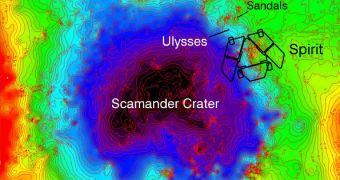When the Martian rover Spirit got stuck at its current location, a patch of loose soil called Troy, everyone at the NASA Jet Propulsion Laboratory, which controls the MER mission, sighed in disappointment. The next six months were spent looking at ways of setting the robot free. When they were finally devised, engineers set them into motion. It was during these escape attempts that the rover made an impressive find. It is not stranded on an ordinary hill, but straight on the rim of a crater, sitting astride the boundary, Space Fellowship reports.
“Spirit had to get stuck to make its next discovery,” Washington University in St. Louis (WUSL) expert Ray Arvidson says. Recently, when the rover started spinning its wheels frantically, as instructed, the movements began to churn the soil underneath. This revealed sulfates right below the robot. “Sulfates are minerals just beneath the surface that shout to us that they were formed in Steam vents, since steam has sulfur in it. Steam is associated with hydrothermal activity – evidence of water – charged explosive volcanism. Such areas could have once supported life,” the expert says.
Spirit's operators were alerted of changes in the scenery ever since the machine entered the region known as Columbia hills. Large concentrations of iron hydroxide, a mineral that forms in the presence of water, replaced the empty soil that the rover had become accustomed to for years before. As the mission progressed, the robot came across more and more rocks that looked like they had been formed in the presence of water. But then came Troy, and the machine got stuck. It was only through this ironic twist that the robot could discover exactly where it was located.
“And most amazingly, the boundary between the sulfate-rich soil and the soil with just the generic concentration of sulfates runs right down the middle of the stranded rover. Spirit is lodged on the edge of a crater – sitting astride the boundary! Also, the robot found that the top of the sulfate material is crusty. Ancient sulfates probably formed this crust as they were processed by variations in climate associated with changes in Mars’ orbit over millions of years,” Arvidson says.
“By being stuck at Troy, Spirit has been able to teach us about the modern water cycle on Mars. We’ve sat here for more than 6 months. That’s a long time to take measurements. We’ve learned a lot. Troy is a good place to be under siege, but we’re ready to leave,” the expert concludes.

 14 DAY TRIAL //
14 DAY TRIAL //